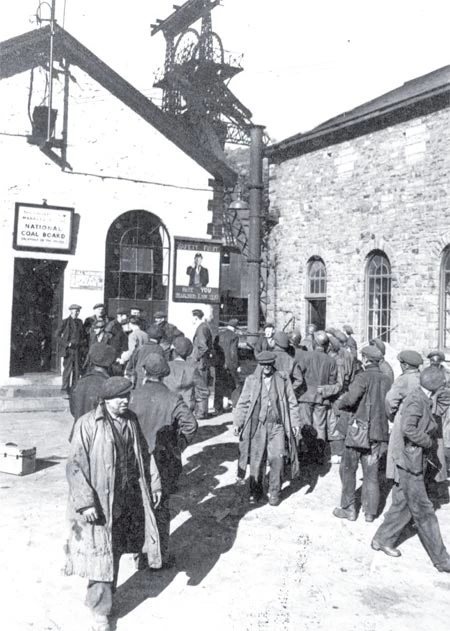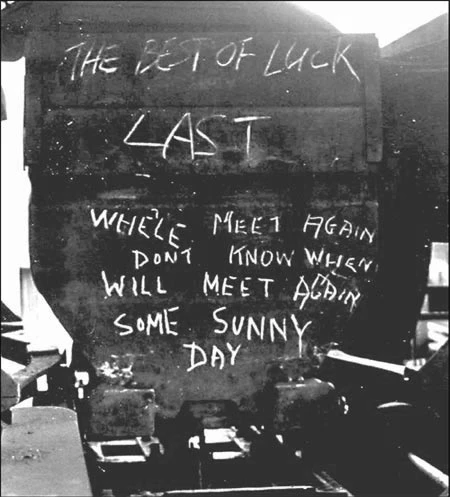Y Bwrdd Glo Genedlaethol yn Ne Cymru
Diwrnod Breinio
O ganlyniad i hanes digalon y diwydiant glo rhwng y ddau ryfel byd, rheolaeth y llywodraeth drosto yn ystod yr Ail Ryfel Byd a'r angen am lo ym Mhrydain ar ôl y rhyfel, roedd hi bron yn anorfod y byddai'r diwydiant yn cael ei wladoli ar ôl ethol llywodraeth Lafur ym 1945.
Croesawyd y 'Diwrnod Breinio', 1 Ionawr 1947, i raddau helaeth yng nglofeydd Cymru. Daeth maes glo de Cymru yn rhan o Ranbarth De Orllewin y Bwrdd Glo Cenedlaethol.
Ymhlith yr asedau a ddaeth i ddwylo'r NCB yn y Deyrnas Unedig roedd dros 1,400 o byllau glo, 225,000 erw o dir amaethyddol, 140,000 o dai glowyr, siopau, swyddfeydd, gwestai, pyllau nofio, un gwersyll gwyliau ac un trac seiclo!
Buddsoddiad A Siom
Buddsoddwyd swm sylweddol o ganlyniad i'r Gwladoli. Rhwng 1948 a 1953, buddsoddwyd bron £32 miliwn yn ardal Caerdydd. Costiodd gwaith ailadeiladu Glofa Nantgarw yn unig £41/2 miliwn. Bu cynnydd yn y mecaneiddio ar y ffas lo ac ymgyrchoedd i wella iechyd a diogelwch.
Cau Pyllau A Thrychinebau
Hyd yn oed yn nyddiau cynnar yr NCB, roedd tuedd i gau pyllau bach nad oedd yn talu'r ffordd ac i addrefnu'r rhai mwy. Fodd bynnag, erbyn y 1960au, dechreuwyd gadael i faes glo'r de ddirywio'n fwriadol. Ni fu i'r un maes glo arall ym Mhrydain ddioddef y fath grebachu mileinig - ym 1960 roedd 106,000 o lowyr yn ne Cymru, erbyn 1970 doedd dim ond 60,000. Bu'n rhaid arafu'r broses o gau'r pyllau yn ystod argyfwng olew'r Dwyrain Canol ynghanol y 1970au.
Ym 1960, lladdwyd 45 o lowyr gan danchwa yng Nglofa Six Bells, ac ar fore Gwener, 21 Hydref 1966, llithrodd darn mawr o domen rwbel Glofa Merthyr Vale i lawr y bryn I bentref Aberfan, gan ladd 144 o bobl yn cynnwys 116 o blant.
1960au
Yn y 1960au y datblygwyd 'archbyllau' mawr newydd Glofeydd Aber-nant, Brynlliw a Chynheidre ac y buddsoddwyd symiau sylweddol yn ad-drefnu glofeydd fel Coegnant, Deep Navigation a Merthyr Vale.
Dyma'r degawd bod holl fwynwyr Prydain yn cael yr un gyfradd dâl.Ar y cyfan, roedd y rheolwyr a'r undebau llafur yn croesawu'r cytundeb hwn er i lawer o ddynion weld cwymp sylweddol yn eu hincwm. Daeth y Cytundeb â theimlad o undod rhwng holl feysydd glo y DU ac fe arweiniodd hynny, mewn ffordd, yn y pen draw, at streiciau cenedlaethol 1972 a 1974, a ymladdwyd dros gyflogau. Anghydfod 1974 a arweiniodd at gwymp y llywodraeth Geidwadol.
Y Blynyddoedd Olaf
Erbyn dechrau'r 1980au, roedd diwydiant glo Prydain ymhlith y mwyaf diogel a'r mwyaf effeithlon yn Ewrop. Fodd bynnag, roedd llywodraeth Geidwadol newydd wedi'i hethol ac roedd cynlluniau ar y gweill i gau rhagor o byllau. Roedd meysydd glo Cymru yn fwy tebygol o ddioddef gan fod y glofeydd yn hen a'r ddaeareg yn achosi problemau.
Er bod y cynlluniau i gau glofeydd wedi'u derbyn yn anfoddog yn y gorffennol, y tro hwn galwyd am weithredu diwydiannol gan nad oedd swyddi eraill i'w cael ar gyfer y dynion. Cychwynnodd streic fawr olaf y glowyr ym mis Mawrth 1984 a pharodd flwyddyn. Gorchfygwyd y glowyr a chwalwyd diwydiant glo Cymru.
Yn ystod y ddeng mlynedd nesaf daeth gwladoli'r diwydiant glo i ben. Ym 1994 caewyd pwll glo Tŵr, sef pwll glo olaf Cymru, gan y Bwrdd Glo Cenedlaethol (yn ddiweddarach Glo Prydain). Fodd bynnag, roedd rhai o'r glowyr yn argyhoeddedig bod y pwll yn effeithiol yn economaidd, ac fe gyfunodd 239 ohonynt eu harian diswyddo i brynu'r pwll. Parhaodd y pwll i fod yn weithredol tan iddo gau am y tro olaf ar 25 Ionawr 2008, gan ddirwyn 200 mlynedd o gloddio glo de Cymru i ben.
Mae'r erthygl hon yn ffurfio rhan o lyfryn yn y gyfres Glo a gynhyrchwyd gan Big Pit Amgueddfa Lofaol Cymru.



sylw - (6)
The photograph is definitely Lewis Merthyr Colliery and shows men around the old lamp room following Nationalisation in 1947. The building to the right is the 'Bertie' (downcast shaft) winding house.
A new lamp room was later installed between the two shafts, and the one shown in the photograph was demolished sometime in the 60s/70s (?).
The headgear and winding house shown in the photograph have now been preserved as part of the Rhondda Heritage Park, Trehafod.
Best wishes
Ceri Thompson, Curator, Big Pit: National Coal Museum
I have passed this onto our Curator for our records to be updated.
Thank you for taking the time to let us know the correct information.
Graham Davies
Digital Team.
Actually, It shows miners returning to the surface the end of the morning shift at the Fernhill Colliery, #4 shaft, Blaenrhondda, taken sometime in the 1960's.
The NCB employee in the right centre of the picture, his raincoat open and facing directly at the camera, is my late father. He was a lifetime resident of Treorchy, Rhondda and an underground coalmine worker for over 50 years.
Alun Jones, resident of Vancouver Island. Canada.
Dear Mike H
As there were around 3,000 coal mines in Wales working at various times during the last 200 years it would be a mammoth task to produce a potted history. However, if you are interested in more modern mines, I would suggest 'Collieries of South Wales, volumes 1 and 2' by John Cornwell who was a photographer working with the NCB during the late 1970s/early 1908s. These two volumes contain some excellent photographs and are well worth obtaining.
“GAZEETTER OF THE COAL MINES OF SOUTH WALES & MONMOUTHSHIRE” by Tony Cooke is also worth obtaining as it contains a huge amount of information on individual collieries from the early days of the industry to the present century.
The development of the Welsh coalfields is charted in the 'History of British Coal', which is in 6 Volumes by various authors.
If you would like further information please contact me at Big Pit on 02920 573660.
Best wishes
Ceri Thompson, Curator (Welsh Coalmining Collections)